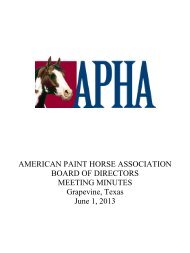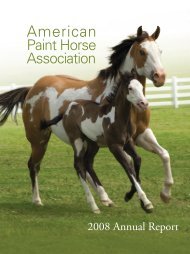Coat Color Genetics - Press - American Paint Horse Association
Coat Color Genetics - Press - American Paint Horse Association
Coat Color Genetics - Press - American Paint Horse Association
You also want an ePaper? Increase the reach of your titles
YUMPU automatically turns print PDFs into web optimized ePapers that Google loves.
Understanding genes, simple dominance and the Punnett Square<br />
Before you begin breeding for color, there<br />
are a few basic genetic concepts you should<br />
understand. Though genetics can seem<br />
daunting at first, by understanding genes<br />
and simple dominance, and knowing how to<br />
use the Punnett Square, any horse owner<br />
can plan their color breeding program with<br />
confidence.<br />
Genes<br />
Genes are the basic units of inheritance.<br />
Genes are linked to form a chromosome<br />
similar to the way pearls are threaded<br />
together to make a strand. Each particular<br />
species has a specific number of chromosomes<br />
(64 for the horse), and each chromosome<br />
has a duplicate mate.<br />
Each gene on the chromosome has a<br />
mate, or allele, in exactly the same place, or<br />
loci, on each of the chromosome’s matched<br />
pair. Basically, each pair of genes codes for<br />
a specific job. A pair of genes can control<br />
something as obvious as whether or not a<br />
cow will have horns, or it may be as subtle<br />
as coding for a specific portion of a bimolecular<br />
molecule, or controlling the function of<br />
other genes.<br />
During the cell division in which one cell<br />
divides into either two egg or two sperm<br />
cells, only one member of each chromosome<br />
pair goes into each new cell. This<br />
provides every sperm and egg with only<br />
one copy of each gene. Upon fertilization,<br />
every chromosome, and therefore every<br />
gene, is reunited with its corresponding<br />
mate to create a unique individual.<br />
In coat color genetics, one of the goals is<br />
to identify the possible genes in the parents<br />
4 • APHA <strong>Coat</strong> <strong>Color</strong> <strong>Genetics</strong> Guide<br />
and predict the probability of coat colors in<br />
their offspring. To help keep track of the<br />
genes whose function is thought to have<br />
been identified, geneticists assign a letter<br />
of the alphabet to the pair.<br />
Understanding Simple Dominance<br />
Gene interactions can be complex and<br />
confusing. Fortunately, some genes adhere<br />
to a relationship based upon simple dominance.<br />
Within this framework, there are two<br />
basic expressions of the same gene—one<br />
dominant, one recessive. The recessive<br />
form of the gene is submissive to the dominant<br />
form. The recessive gene is expressed<br />
only when both copies of the gene are in the<br />
recessive form.<br />
Capital letters usually indicate dominant<br />
genes. Lowercase letters indicate recessive<br />
genes. This system is complicated by the<br />
use of superscripts. For example, the dominant<br />
form of the gene creating palomino is<br />
CC cr . The recessive is referred to as C.<br />
Regardless of the letters used, each<br />
individual obtains one copy of the gene<br />
from each parent. In the system of simple<br />
dominance, this pairing occurs in one of<br />
three ways:<br />
Homozygous dominant—In this instance,<br />
both alleles are in the dominant form, as<br />
indicated by a capital letter, for example,<br />
AA. The color determination is under the<br />
control of the dominant gene, and all offspring<br />
created from this individual can only<br />
receive a copy of the dominant gene.<br />
Homozygous recessive—Here, both<br />
copies of the allele are in the recessive<br />
form, for example, aa. The color determi-<br />
nation is under the control of the recessive<br />
gene, and in many cases this means there<br />
is no expression.<br />
For example, the recessive form of the<br />
gene for roan (Rn+), palomino (C), gray (g),<br />
tobiano (to) and dun (Dn nd ) allow the body<br />
coat to be expressed by the dominant gene.<br />
Foals with a homozygous recessive parent<br />
will receive one copy of this parent’s<br />
recessive gene.<br />
Heterozygous—One member of the pair<br />
is dominant, while the other is recessive, for<br />
example, Aa. The dominant form is in control<br />
of the expression. Offspring have a 50-<br />
50 chance of inheriting either the dominant<br />
or the recessive gene.<br />
Using the Punnett Square<br />
A Punnett Square is a simple way to predict<br />
the possible genetic combinations from<br />
the mating of two individuals. To use this tool,<br />
first draw a square. Across the top, list the<br />
gene combination of the stallion. Down the<br />
left side, list the gene combination of the<br />
mare. Then, bring one value from each parent<br />
into the corresponding box within the square.<br />
Stallion (aa) Mated to Mare (Aa)<br />
Mare A<br />
Stallion<br />
a<br />
Aa<br />
a<br />
Aa<br />
a aa aa<br />
Each box represents a 25 percent<br />
chance of a specific gene combination. In<br />
the example above, foals from this cross<br />
have a 50 percent chance of getting the Aa<br />
combination and a 50 percent chance of<br />
getting the aa combination.




